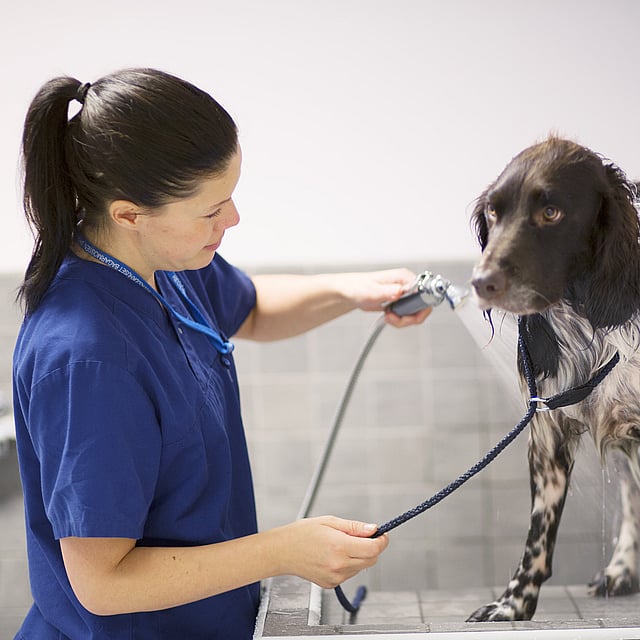How can the vet help me with grooming my dog? #
We are happy to help you with bathing your dog or cat, clipping its fur or trimming its nails if you are afraid of injuring your pet. For animals in which these procedures cause stress, fear or aggression, we can use a light anaesthetic with your agreement.
Dog grooming – why is it important? #
Grooming is an important part of animal hygiene. It removes loose hairs, dirt and possibly bits of plants like burs. Inadequately groomed fur can not only harbour fleas and parasites but can also lead to other serious diseases.
What does dog grooming consist of? #
Bathing
A bath is important now and again to remove major or dried-in dirt. This does not mean a classic bath in a full bathtub, however, but showering the body or certain parts of it such as the paws or anal area. You should use special animal washing products and shampoos of specific pH so as not to damage the fur and skin.
Brushing
Brushing and combing not only untangle the hair, but thorough brushing also acts as a massage that promotes the circulation and wakes up the immune system. Not all dogs and cats have to be brushed. The need for this depends on the length and texture of the coat.
Clipping the fur
The purpose of an dog's coat is to regulate body temperature in heat and cold. Many breeds have a very long or thick coat and therefore suffer from the heat in the summer months. It is important to brush out the undercoat well and there are special brushes for this. Whether an animal should be sheared, trimmed or just well brushed depends greatly on the coat structure. If the fur is already matted and tangled, these parts should be removed with clippers or scissors as they lead to pain and skin damage in the animal.
Examining the fur for parasites (e.g., ticks or burs)
Check your pet’s fur regularly for fleas, ticks, burs, grass seed and other impurities. The checks should be more frequent in animals that often run around in undergrowth, fields and woods. Burs in the fur can be very painful and are a problem especially in animals with a longer coat. If you find anything, this must be brushed out or removed, as in the case of an attached tick. In the summer it is important to examine the paws after every walk for grass seeds (awns) because they work their way into the skin rapidly, leading to inflammation and pain there.
Correct dog grooming #
Give your dog a bath only when the coat is dirty, he has rolled in muck or something similar and smells unpleasant. After a thorough bath, the dog’s skin needs up to six weeks to regenerate so you should not bathe your dog too often. If you are considering using a spot-on product against parasites, do not apply this directly after or before a bath as it cannot spread due to the lack of a grease film.
Long-haired and coarse-haired dogs
Dog grooming for long-haired breeds includes regular brushing as the coat becomes matted otherwise. First comb loose hairs out of the outer coat and undercoat with a comb or curry comb. Then use a stiff brush, passing it vertically through the fur. Grooming the coat of Maltese terriers, PONs (Polish lowland sheepdogs) and Pulis is particularly laborious as the coat is not only long but also curly.
It is often necessary to trim the fur or have it sheared completely. When it is trimmed, dead and loose hairs as well as certain healthy hairs are plucked out using the fingers, clippers or other special equipment. The fur of coarse-haired dog breeds should always be trimmed, e.g., many terriers, schnauzers and the wire-haired dachshund. Shearing a dog’s coat is more complex than trimming and should be done by a professional, if possible.
Short-haired dogs
For short-haired breeds, thorough brushing in spring and autumn during moulting is sufficient. As the hair is very short, it cannot become tangled or matted. Dirt can also not get trapped in it so easily.
Look out for dandruff in dogs #
Dandruff in dogs and cats is generally harmless and is usually associated with moulting.
If your dog has dandruff and if it also suffers from itching, a vet should be consulted. Dandruff is often a sign of disease. For example, chronic diseases, allergies, parasite infestation or diabetes can be expressed in the form of flaking skin. An examination by the vet will provide information about the cause of the dandruff so that the appropriate treatment can be started. A blood test is often necessary also for investigation, as some internal diseases are revealed through poor skin condition, so they ultimately are not a skin disease.
Don’t overdo dog grooming #
Grooming should not be overdone as this can also produce health problems. For instance, you should not bathe your dog too often. When long thick fur becomes wet several times a day, it often doesn’t dry properly. The moisture can then promote infections of the animal’s skin. Brushing too often can also remove many healthy hairs.
© AniCura
